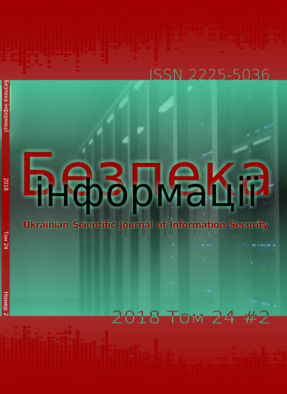Удосконалена функція хешування MD4
DOI:
https://doi.org/10.18372/2225-5036.24.12955Ключові слова:
криптографія, функція хешування, цілісність інформації, захист інформації, криптостійкістьАнотація
Цілісніть важливих файлів операційної системи, програм чи даних контролюється функціями хешування. Відомі алгоритми хешування не дозволяють у повній мірі вирішувати питання забезпечення криптографічної стійкості та високої швидкодії алгоритмів. Тому розробка нових та удосконалення існуючих функцій хешування все ще актуальна задача. З огляду на це, у роботі запропоновано удосконалену функцію хешування newMD4, на основі оригінальної функції хешування MD4. Розроблена функція хешування newMD4 має декілька покращень, таких як, збільшення довжини хеш-коду, зміну додаткових функцій ,,, збільшення кількості етапів стиснення. Отримані результаті було підтверджено експериментальними дослідженнями. За однакових умов, проведені експериментальні дослідження з оцінки швидкісних характеристик, які показали, що шифр newMD4 перевершив свого попередника на 1,47 разів. Для дослідження статистичних характеристик використано тести NIST, так як при незначній модифікації newMD4 можна застосовувати для генерації псевдовипадкових послідовностей. Кількість тестів, які пройшли тестування ≥99% послідовностей, у 1,22 разів більша ніж у MD4.Посилання
Мухачева В.А., Хорошко В.А. Методы практической криптографии. К.: ООО «Полиграф Консалтинг», 2005, 215 с.
Хеш функції и цифрові підписи. URL: http://izi.vlsu.ru/teach/books/913/theory.html
Шнайер Б., Фергюсон Н. Практическая криптография. М: Диалектика, 2005, С. 105
Joux A. Multicollisions in Iterated Hash Functions. Application to Cascaded Constructions. URL: https://www.iacr.org/archive/crypto2004/31520306/multicollisions.pdf
Бондаренко В.В. Введение в криптографию : Учебное пособие. С: СГУ, 2000, С. 234
Rivest R., The MD4 Message-Digest Algorithm. URL: https://tools.ietf.org/html/rfc1320
Rivest R., The MD5 Message-Digest Algorithm. URL: https://www.ietf.org/rfc/rfc1321
Eastlake D., US Secure Hash Algorithm 1 (SHA1) URL: https://tools.ietf.org/html/rfc3174
Bider D., SHA-2 Data Integrity Verification for the Secure Shell (SSH) Transport Layer Protocol. URL: https://tools.ietf.org/html/rfc6668
V. Dolmatov. GOST R 34.11-2012: Hash Function. URL: https://tools.ietf.org/html/rfc6986
Keromytis A., The Use of HMAC- RIPEMD-160-96 within ESP and AH. URL: https://www.ietf.org/rfc/rfc2857.txt
S. Miyaguchi, K. Ohta, and M. Iwata (November 1990). "128-bit hash function (N-hash)". NTT Review. 2 (6): c. 128–132.
Eli Biham, Adi Shamir. Differential cryptanalysis of Snefru, Khafre, REDOC-II, LOKI and Lucifer (Extended Abstract).
Dobraunig Christoph, Analysis of the Kupyna-256 Hash Function. URL: https://eprint.iacr.org/2015/956.pdf

